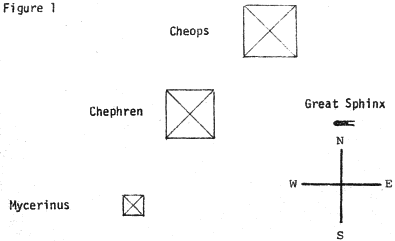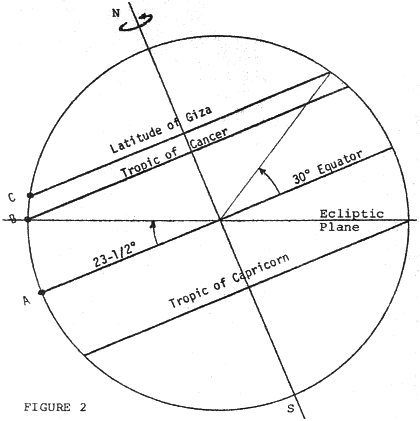
Stuart W. Greenwood, “Giza: Extraterrestial focal point?”
Ancient Skies, 2(1), 1–2 (March–April 1975).
This article, a copy of which was placed in the Pyramid Folio, was first published in Ancient Skies, the official logbook of the Ancient Astronaut Society.
© Copyright 1975 Ancient Astronaut Society. Republished here by permission.
{1}
Giza is the site of the pinnacle of architectural achievement in the ancient world. The pyramids of Cheops, Chephren and Mycerinus, together with the Great Sphinx, still stand as permanent monuments to an astonishing level of cultural and technological attainment, dating back to 2,500 B.C. according to the consensus of archeological judgment.
To establish some perspective in our appreciation of the distinctive nature of these monuments we need to recognize that these works were constructed at a time more distant from the life of Christ than we are today. In our attempts at assessing the possibility that man was directly affected by extraterrestrial intervention in early times, are there any features of the monuments at Giza that serve to enlighten our studies?

The pyramids are closely aligned with their base lines in the N–S, W–E directions respectively. The pyramid of Cheops (or Great Pyramid) has an alignment that corresponds within a few minutes of arc (Ref. 1). The Great Sphinx “gazes toward the eastern horizon, where the gods were thought to dwell” (Ref. 2). The Giza complex is shown in Fig. 1, and the astronomical significance of the alignments is evident.
Giza lies within one minute of latitude 30°, almost exactly a third of the distance from the Equator to the North Pole. It is situated at the apex of the Nile Delta across the Nile from the ancient center for Sun-worship, Heliopolis, and close to the modern city of Cairo. It is a part of the matrix of centers of early civilization that flowered around the Eastern end of the Mediterranean, the Red Sea and the Persian Gulf. It is unquestionably a focal point of ancient civilization. There is unquestionable astronomical significance in the alignment of its awesome structures, whether or not such significance was a prime consideration in their design. We now search for any possible astronautical significance in the context of the ancient astronaut hypothesis.

The Earth spins about its axis in the W–E direction (Fig. 2). The maximum launch assist from this effect would be available at a point on the Equator, as at A. For flights between planets in our Solar System, however, the transfer plane will lie close to the Ecliptic Plane, the plane of the Earth’s orbit around the Sun, so a launch site on one of the tropics would be preferred. Once each day, any point on either of the tropics (at latitudes 23½°) will touch the Ecliptic plane, as at B, and this corresponds to a preferred launch opportunity. The rotational speed of the Earth at the tropics is only 8% lower than that at the Equator, and the gravitational fields of the Earth and the Sun are suitably oriented for transfer in the Ecliptic Plane.
The launch site at Cape Canaveral is situated at a latitude of 28½°, just N of the Tropic of Cancer. For such modest {2} departures from the latitudes of the tropics the launch energy requirement is not seriously increased. Giza, at latitude 30°, corresponds to a velocity contribution from the Earth’s spin only 13% less than that provided at the Equator. There is, of course, a progressive mismatch between the gravitational fields of the Earth and the Sun for launches progressively distant from the tropics. Nevertheless, for energy-limited vehicles operating to and from the nearest planets of the Solar System, Giza is a relatively attractive location for a space center.
A launch from Giza would preferably take place when the site was at C in Fig. 2. The launch would be in the W–E direction to take advantage of the Earth’s spin. The Great Sphinx faces in that direction and its eyes are directed toward, or evidently just above, the Eastern horizon. That is “where the gods were thought to dwell.” The myth, if that is all it is, is compatible with the possibility that ancient astronauts departed from Giza on comparatively flat trajectories of departure over the Eastern horizon on return voyages to their home planet in the Solar System.
We are engaged in the realm of reasoned speculation and need to recognize that any or all of our suggestions may have to be revised in the future. However, with this proviso, we proceed with our adventure and enquire what type of vehicle is implied by our deductions. A space vehicle with a flat trajectory of departure might well possess many of the characteristics of an aircraft at take-off – in other words it would employ wings for lift. To the ancient it may well have appeared to be a mechanical bird.
The legend of the Phoenix includes some remarkably suggestive features. Only one existed at any time, suggesting a machine rather that a species. Its time of arrival was a matter for dispute at Heliopolis, the center for Sun-worship, but it was supposed to visit every 500 years. As the end of its life approached, the Phoenix constructed a nest, set itself on fire, and was consumed. A new Phoenix miraculously emerged from the pyre.
The nest may be interpreted as a specially prepared launch site, and the pyre as the exhaust glare at launch. As a winged vehicle bound for one of the nearer planets it departed over the Eastern horizon. The machine, or its replacement, then returned to continue contact through the priests at Heliopolis.
| (1) | I.E.S. Edwards, The Pyramids of Egypt, Penguin Edition, 1961. |
| (2) | Gerald S. Hawkins, “Celestial Clues to Egyptian Riddles,” Natural History, April, 1974. |
Addendum (2013)
In a letter dated 10 January 2013, Dr Greenwood writes: “I now feel I should have emphasised equatorial locations for suitable launch sites alongside those in tropical regions.”